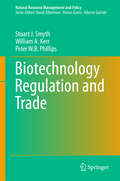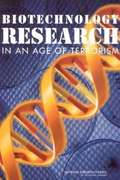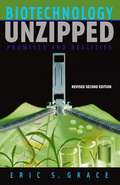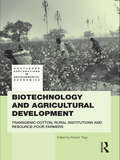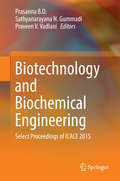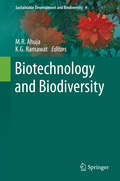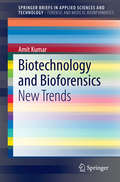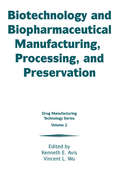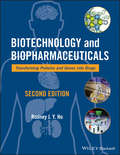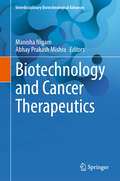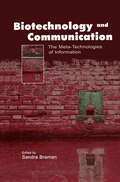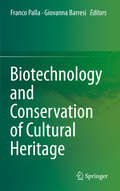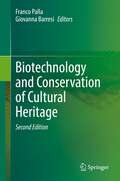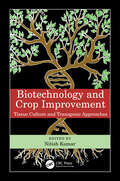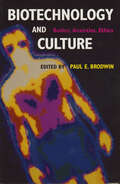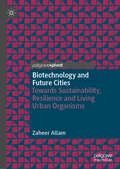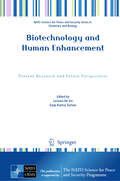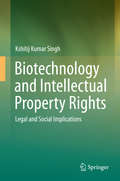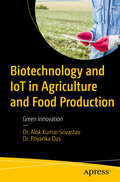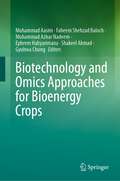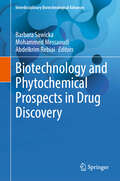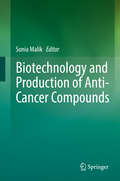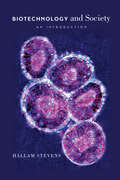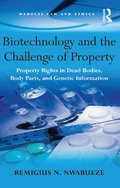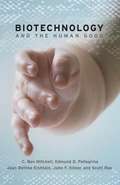- Table View
- List View
Biotechnology Regulation and Trade (Natural Resource Management and Policy #51)
by Stuart J. Smyth William A. Kerr Peter W. B PhillipsThis book discusses the regulatory and trade challenges facing the global adoption of biotechnological products and offers strategies for overcoming these obstacles and moving towards greater global food security. The first section of the book establishes the context of the conflict, discussing the challenges of global governance, international trade, and the history of regulation of genetically modified (GM) crops. In this section, the authors emphasize the shift from exclusively science-based regulation to the more socio-economically focused framework established by the Cartagena Protocol on Biosafety, which was adopted in 2000. The second section of the book provides a snapshot of the current state of international GM crop adoption and regulation, highlighting the US, Canada, and the EU. The final section of the book identifies options for breaking the gridlock of regulation and trade that presently exist. This book adds to the current literature by providing new information about innovative agricultural technologies and encouraging debate by providing an alternative to the narratives espoused by environmental non-governmental organizations. This book will appeal to students of economics, political science, and policy analysis, as well as members of regulatory agencies and agricultural industry firms.
Biotechnology Research In An Age Of Terrorism
by National Research Council of the National AcademiesIn recent years much has happened to justify an examination of biological research in light of national security concerns. The destructive application of biotechnology research includes activities such as spreading common pathogens or transforming them into even more lethal forms. Policymakers and the scientific community at large must put forth a vigorous and immediate response to this challenge. This new book by the National Research Council recommends that the government expand existing regulations and rely on self-governance by scientists rather than adopt intrusive new policies. One key recommendation of the report is that the government should not attempt to regulate scientific publishing but should trust scientists and journals to screen their papers for security risks, a task some journals have already taken up. With biological information and tools widely distributed, regulating only U.S. researchers would have little effect. A new International Forum on Biosecurity should encourage the adoption of similar measures around the world. Seven types of risky studies would require approval by the Institutional Biosafety Committees that already oversee recombinant DNA research at some 400 U.S. institutions. These “experiments of concern” include making an infectious agent more lethal and rendering vaccines powerless.
Biotechnology Unzipped: Promises and Realities
by Eric S. GraceBiotechnology may raise more hope and fear...revelation and confusion...excitement and alarm than any other term in today's headlines. In Biotechnology Unzipped, scientist and skilled science popularizer Eric Grace helps readers understand what biotechnology is and what implications it holds for all of us. Grace offers a reader-friendly explanation of how we came to where we are--from the coining of the word "cell" in 1665 through Darwin's breakthrough insight on evolution and the unraveling of the DNA helix to the 1997 announcement of the cloning of Dolly the sheep. This book uses everyday metaphors to help readers understand the genetic code and how it works to produce every form of life. Grace deals frankly with the reality that biotechnology is first and foremost a commercial activity. Focusing on the ethical implications, he looks at the scope of public opinion, the role of the media, the vulnerability of the poor to exploitation, and the problem of patenting life itself. Grace explores the promises and realities of biotechnology in major arenas: The human body. The medical industry is today's biggest customer for biotechnology, and Grace presents its application as a continuum from the earliest experiments with skin grafting in the 1800s. He reports on the progress of gene therapy and other medical marvels--yet Grace argues that high-tech medicine does not guarantee longer, healthier lives any more than high-tech weapons guarantee world peace. The farm. Is biotechnology the answer to world hunger or is it self-serving rhetoric from agribusiness? Grace explores the reality between these two points of view through examples, including the controversy over bovine growth hormone, increased use of herbicides and pesticides, and genetic modification of plants. The environment. Biotechnology Unzipped looks at the promise of microbes cleaning up pollutants such as the Exxon Valdez spill. Alternate Selection, Newbridge Science Book Club.
Biotechnology and Agricultural Development: Transgenic Cotton, Rural Institutions and Resource-poor Farmers (Routledge Explorations in Environmental Economics)
by Robert TrippThis book addresses the continuing controversy over the potential impact of genetically modified (GM) crops in developing countries. Supporters of the technology claim it offers one of the best hopes for increasing agricultural production and reducing rural poverty, while opponents see it as an untested intervention that will bring corporate control of peasant farming. The book examines the issues by reviewing the experience of GM, insect-resistant cotton, the most widely grown GM crop in developing countries. The book begins with an introduction to agricultural biotechnology, a brief examination of the history of cotton production technology (and the institutions required to support that technology), and a thorough review of the literature on the agronomic performance of GM cotton. It then provides a review of the economic and institutional outcomes of GM cotton during the first decade of its use. The core of the book is four country case studies based on original fieldwork in the principal developing countries growing GM cotton (China, India, South Africa and Colombia). The book concludes with a summary of the experience to date and implications for the future of GM crops in developing countries. This review challenges those who have predicted technological failure by describing instances in which GM cotton has proven useful and has been enthusiastically taken up by smallholders. But it also challenges those who claim that biotechnology can take the lead in agricultural development by examining the precarious institutional basis on which these hopes rest in most countries. The analysis shows how biotechnology’s potential contribution to agricultural development must be seen as a part of (and often secondary to) more fundamental policy change. The book should be of interest to a wide audience concerned with agricultural development. This would include academics in the social and agricultural sciences, donor agencies and NGOs.
Biotechnology and Biochemical Engineering: Select Proceedings of ICACE 2015
by Prasanna B. D. Sathyanarayana N. Gummadi Praveen V. VadlaniThis book serves to highlight the seamless integration of the sciences leading to sustainable technologies. Chemical engineering is one of the major disciplines catering to the societal needs in the fields of energy, environment and materials. The chapters of this book have been selected to encompass the latest in industrial biotechnology and biochemical engineering principles and applications. The chapters are included here after careful review for content and depth. The book focuses on the relatively new areas of molecular biotechnology and nanotechnology which have a strong impact at the fundamental and process levels in chemical engineering. The book also covers analytical procedures, experimental techniques and process analysis in bioprocessing, bioremediation, green separation methods, and emerging nanoparticle applications. It should be useful to students, academicians, and practitioners alike.
Biotechnology and Biodiversity: Biology, Biotechnology And Applications (Sustainable Development and Biodiversity #4)
by M. R. Ahuja K. G. RamawatThe purpose of this book is to assess the potential effects of biotechnological approaches particularly genetic modification on biodiversity and the environment. All aspects of biodiversity such as ecological diversity, species diversity and genetic diversity are considered. Higher organisms contain a specific set of linear DNA molecules called chromosomes and a complete set of chromosomes in an organism comprises its genome. The collection of traits displayed by any organism (phenotype) depends on the genes present in its genome (genotype). The appearance of any specific trait also will depend on many other factors, including whether the gene(s) responsible for the trait is/are turned on (expressed) or off, the specific cells within which the genes are expressed and how the genes, their expression and the gene products interact with environmental factors. The primary biotechnology which concerns us is that of genetic manipulation, which has a direct impact on biodiversity at the genetic level. By these manipulations, novel genes or gene fragments can be introduced into organisms (creating transgenics) or existing genes within an organism can be altered. Transgenics are a major area of concern, combining genes from different species to effectively create novel organisms. Current rates of disappearance of biological and cultural diversity in the world are unprecedented. Intensive resource exploitation due to social and economic factors has led to the destruction, conversion or degradation of ecosystems. Reversing these trends requires time to time assessment to integrate conservation and development.
Biotechnology and Bioforensics: New Trends (SpringerBriefs in Applied Sciences and Technology)
by Amit KumarThis Brief covers broad areas of Applied Biology specifically into the domains of Biotechnology/Biomedicine and Forensic Science. Chapters included here would also explain the role of bioinformatics in protein and gene characterization, modeling of the protein structure, survey related to the chromosomal effect on Human Disorders like Diabetes and Cardiac Problems. This Brief is full of Innovative Literature like Use of Microbes in Electricity Production, Brain connection to Type 2 Diabetes etc. Interesting issues in Forensic biology and the aspects of Bioforensics like STR profiling of exhumed bones makes this brief truly useful and informative for Researchers. It also includes the advancements and new ideologies in understanding crop improvements & crop quality. This Brief witnesses Innovative Research related to the Bio and Agri software development too which are capable of accelerating Insilico biological data analysis.
Biotechnology and Biopharmaceutical Manufacturing, Processing, and Preservation
by Kenneth E. Avis and Vincent L. WuIn this unique book, experts describe practices applicable to the large-scale processing of biotechnological products. Beginning with processing and bulk storage preservation techniques, the book provides strategies for improving efficiency of process campaigns of multiple products and manufacturing facilities for such processing techniques. Large-scale chromatography for the purification of biomolecules in manufacturing and lyophilization of protein pharmaceuticals are discussed. Includes a case study on blow-fill-seal processing technology and a chapter on economic and cost factors for bioprocess engineering.
Biotechnology and Biopharmaceuticals
by Rodney J. HoBiotechnology and Biopharmaceuticals: Transforming Proteins and Genes into Drugs, Second Edition addresses the pivotal issues relating to translational science, including preclinical and clinical drug development, regulatory science, pharmaco-economics and cost-effectiveness considerations. The new edition also provides an update on new proteins and genetic medicines, the translational and integrated sciences that continue to fuel the innovations in medicine, as well as the new areas of therapeutic development including cancer vaccines, stem cell therapeutics, and cell-based therapies.
Biotechnology and Cancer Therapeutics (Interdisciplinary Biotechnological Advances)
by Abhay Prakash Mishra Manisha NigamThis book explores new ground in the field of cutting-edge cancer treatment modalities by presenting contemporary biotechnological developments as a component of cancer targeting techniques. It addresses the application of modern technologies in cancer detection, targeting, and the development of therapeutic strategies across fifteen comprehensive chapters. The book emphasizes the advantages of molecular techniques for cancer therapies, such as molecular diagnosis, cell and gene therapy, and immunotherapy, with a dedicated chapter on personalized cancer therapy to critically analyze the progression toward precision strategies. The chapters cover topics such as molecular biomarkers, microRNAs, and the potential of nanomedicine in cancer treatment. The authors provide expert analysis on the latest research, offering insights into the outcomes of scientific and clinical trials. Readers will also discover discussions on drug resistance, novel molecular targets, and the integration of biotechnology in drug discovery and development. Particular attention is given to the role of epigenetics and RNA interference in cancer therapy, as well as the challenges and future prospects of personalized medicine. This book is designed specifically for oncologists, cancer biologists, researchers, academicians, and students interested in understanding the most cutting-edge biotechnological aspects of cancer therapeutics. It offers a comprehensive overview of cancer prevention, therapeutics, and treatments through the perspectives of technology, medicine, and alternative therapies. Researchers in the field of biotechnology and cancer therapy will find this book invaluable for its detailed discussions and insights into the latest advancements. It serves as a crucial tool for those working in this area, providing a valuable resource for understanding the complexities of cancer therapies and fostering progress in the field.
Biotechnology and Communication: The Meta-Technologies of Information (Routledge Communication Series)
by Sandra BramanThis volume examines the convergence of biotechnology and communication systems and explores how this convergence directly influences our understanding of the nature of communication. Editor Sandra Braman brings together scholars to examine this convergence in three areas: genetic information and "facticity"; social issues and implications; and the economic and legal issues raised by the production and ownership of information. The work highlights the sophisticated processes taking place as biotechnology and information technology systems continue to evolve. The chapters in this book approach the complex history of this topic and the issues it raises from a number of directions. It begins by examining the shared features and spaces of biotechnology and digital information technologies as meta-technologies--qualitatively distinct from both the tools first used in the premodern era and the industrial technologies that characterized modernity. Next, the book explores what is and is not useful in treating the types of information processed by the two meta-technologies through a shared conceptual lens and looks at issues raised by the ownership of genetic and digital information. The final chapters are concerned with relationships between information and power. Defining a future research agenda for communication scholarship, this work is beneficial to scholars and students in science communication, cultural studies, information technologies, and sociology.
Biotechnology and Conservation of Cultural Heritage
by Franco Palla Giovanna BarresiThis book provides detailed insights into the role of microorganisms and microbial products in biodeterioration, conservation and restoration of cultural heritage. Topics to be discussed are microbial colonization and their growth control on both artworks and aerosol of indoor environments such as libraries or museums, as well as human health hazard from exposure to microbial agents. In addition innovative biotechnological protocols and strategies for the removal of undesired layers on artwork surfaces are described in detail. Also the advances and perspectives in this emerging biotechnological field are discussed, supported by the latest original findings.
Biotechnology and Conservation of Cultural Heritage
by Franco Palla Giovanna BarresiThis second fully updated and extended edition of Biotechnology and Conservation of Cultural Heritage provides in-depth insights into the role of different microorganisms and microbial compounds in biodeterioration, conservation and restoration of artworks and artifacts. Latest methods to detect, remove and prevent microbial colonization on artwork surfaces and in air environments of libraries and museums are discussed and illustrated by engaging case studies. Furthermore, this edition covers new case studies on Archaeobiology, exploring ways to perform the molecular biology characterization, restoring and protecting museum taxidermal specimens, preserving and guaranteeing the future integrity. Finally, the use of halloysite-nanotubes is investigated to set up innovative protocols in consolidation and long-term protection of waterlogged and archaeological wood. This book addresses to Biologists, Microbiologists, Conservation Scientists and Conservators who are interested in understanding the role of microorganisms and bioactive molecules in conservation projects.
Biotechnology and Crop Improvement: Tissue Culture and Transgenic Approaches
by Nitish KumarBiotechnology and Crop Improvement The green revolution led to the development of improved varieties of crops, especially cereals, and since then, classical or molecular breeding has resulted in the creation of economically valuable species. Thanks to recent developments in biotechnology, it has become possible to introduce genes from different sources, such as bacteria, fungi, viruses, mice and humans, to plants. This technology has made the scientific community aware of the critical role of transgenic, not only as a means of producing stress tolerant crops but also as a platform for the production of therapeutics through molecular farming. Biotechnology and Crop Improvement: Tissue Culture and Transgenic Approaches focuses on important field crops to highlight germplasm enhancement for developing resistance to newly emerging diseases, pests, nutrient- and water-use efficiency, root traits and improved tolerance to increasing temperature and introduces significant recent achievements in crop improvement using methods such as micropropagation, somaclonal variation, somatic embryogenesis, anther/pollen/embryo culture, and compressing the breeding cycle for accelerated breeding and early release of crop varieties. Plant biotechnology has now become an integral part of tissue culture research. The tremendous impact generated by genetic engineering and consequently of transgenic now allows us to manipulate plant genomes at will. There has indeed been a rapid development in this area with major successes in both developed and developing countries. Development of transgenic crop plants, their utilization for improved agriculture, health, ecology and environment and their socio-political impacts are currently important fields in education, research, and industry and also of interest to policy makers, social activists and regulatory and funding agencies. This work prepared with a class-room approach on this multidisciplinary subject will fill an existing gap and meet the requirements of such a broad section of readers. It describes the recent biotechnological advancement and developments in plant tissue culture and transgenic. Plant tissue culture techniques such as such as micropropagation, regeneration, somaclonal variation, somatic embryogenesis, anther/pollen/embryo culture are discussed for genetic improvement of crop plant. Transgenic techniques are discussed for developing resistance to newly emerging diseases, pests, nutrient- and water-use efficiency, root traits, and improved tolerance to increasing temperature. Key Features Shows the importance of plant tissue culture and transgenic technology on plant biology research and its application to agricultural production Provides insight into what may lie ahead in this rapidly expanding area of plant research and development Contains contributions from major leaders in the field of plant tissue culture and transgenic technology This book is devoted to topics with references at both graduate and postgraduate levels. The book traces the roots of plant biotechnology from the basic sciences to current applications in the biological and agricultural sciences, industry, and medicine. The processes and methods used to genetically engineer plants for agricultural, environmental, and industrial purposes along with bioethical and biosafety issues of the technology are vividly described in the book.
Biotechnology and Culture: Bodies, Anxieties, Ethics
by Paul E. BrodwinEssays on technology’s effect on our relationship with our bodies: “A timely and perceptive look . . . at some of the most anxiety producing issues of the day.” —Paul Rabinow, University of California, BerkeleyAs birth, illness, and death increasingly come under technological control, struggles arise over who should control the body and define its limits and capacities. Biotechnologies turn the traditional “facts of life” into matters of expert judgment and partisan debate. They blur the boundary separating people from machines, male from female, and nature from culture. In these diverse ways, they destroy the “gold standard” of the body, formerly taken for granted.Biotechnologies become a convenient, tangible focus for political contests over the nuclear family, legal and professional authority, and relations between the sexes. Medical interventions also transform intimate personal experience: giving birth, building new families, and surviving serious illness now immerse us in a web of machines, expert authority, and electronic images. We use and imagine the body in radically different ways, and from these emerge new collective discourses of morality and personal identity.This book brings together historians, anthropologists, cultural critics, and feminists to examine the broad cultural effects of technologies such as surrogacy, tissue-culture research, and medical imaging. The moral anxieties raised by biotechnologies and their circulation across class and national boundaries provide other interdisciplinary themes for discourse in these essays. The authors favor complex social dramas of the refusal, celebration, or ambivalent acceptance of new medical procedures. Eschewing polemics or pure theory, contributors show how biotechnology collides with everyday life and reshapes the political and personal meanings of the body.Contributors include Paul Brodwin, Lisa Cartwright, Thomas Csordas, Gillian Goslinga-Roy, Deborah Grayson, Donald Joralemon, Hannah Landecker, Thomas Laqueur, Robert Nelson, Susan Squier, Janelle Taylor, and Alice Wexler.“This impressive collection offers a number of rich examples of why the development of anthropological studies of science, technology, and their disruptive social effects is a leading edge of critical enquiry.” —Arthur Kleinman, Harvard University
Biotechnology and Future Cities: Towards Sustainability, Resilience and Living Urban Organisms
by Zaheer AllamThis book explores how biotechnology can lead to the reimagination of cities. In a time where the increasing adoption of technology by cities is leading to unsustainable environmental and economic concerns, biotechnology has enabled new ways of envisioning data and energy storage. Zaheer Allam thus revisits the popular concept of Smart Cities -and its associated Internet of Things (IoT) to explore how the biological sciences, coupled with technology, can be applied to cities; and in doing so, create living urban organisms on an unprecedented scale. This new concept will open up exciting avenues to providing novel solutions for climate change mitigation. The book goes on to address various potential concerns and discusses what regulatory frameworks would be needed to safely implement such a concept. It will be a useful tool for planners, policy makers and engineers as well as for researchers with in interest in the future of our cities.
Biotechnology and Human Enhancement: Present Research and Future Perspectives (NATO Science for Peace and Security Series A: Chemistry and Biology)
by Eyup Kuntay Turmus Luciano De SioThis book provides new insights in the role that biotechnology and human enhancement will play in the following years to come. Based on the experience and know-how of recognized scientists worldwide, a paradigm shift in advanced technologies is highlighted, merging academic and specialized research centers. Indeed, biotechnology and human enhancement play an essential role in emerging fields such as biosensing, medical technologies, and synthetic biology. These technologies are significant for several cross-disciplinary research activities ranging from medicine to electronics. The book promotes a visionary idea that will establish a more vital collaboration to help track down a roadmap for bringing innovative and breakthrough applications to address the key and emerging challenges for the upcoming years. The book is intended to offer a comprehensive overview for both students and experienced researchers about the main research activities developed in recent years that will help realize a more sustainable approach in modern bio-related applications.
Biotechnology and Intellectual Property Rights: Legal and Social Implications
by Kshitij Kumar SinghThis book offers a valuable contribution to contemporary legal literature, providing deep insights into the interface between law and genetics, highlighting emerging issues and providing meaningful solutions to current problems. It will be of interest to a broad readership, including academics, lawyers, policy makers and scholars engaged in interdisciplinary research. In the context of examining and analyzing the legal and social implications arising from the recent conjunction of biotechnology and intellectual property rights, the book particularly focuses on human genes and gene variations. Emphasis is placed on "patent law," as a considerable percentage of genetic inventions are covered by patents. The book presents a comparative and critical examination of patent laws and practices related to biotechnology patents in the United States, Canada, European Union and India, in order to gather the common issues and the differences between them. The international patent approach regarding biotechnology is also analyzed in light of the constant conflict between differentiation and harmonization of patent laws. The book highlights the potential gaps and uncertainties as to the scope of numerous terms such as invention, microorganisms, microbiological processes, and essential biological processes under TRIPS. Also analyzed are the social and policy implications of patents relating to genetic research tools and genetic testing. The intricacies involved in providing effective intellectual property protection to bioinformatics and genomic databases are also examined. Bearing in mind the collaborative nature of bioinformatics and genomic databases, the book evaluates the pros and cons of open biotechnology and assesses the implications of extending intellectual property rights to human genetic resources, before explaining the ownership puzzle concerning human genetic material used in genetic research.
Biotechnology and IoT in Agriculture and Food Production: Green Innovation
by Dr. Alok Srivastav Dr. Priyanka DasExplore the transformative intersection of biotechnology and the Internet of Things (IoT) in modern agriculture. This book delves into sustainable solutions and cutting-edge technologies that are revolutionizing the global food production industry. The book is structured to provide an in-depth understanding of how green innovation is reshaping agriculture. Starting with an introduction to sustainability in agriculture, it traces the evolution from traditional farming to smart farming methods, where IoT and Biotechnology come together to optimize crop management, soil health, and resource utilization. Key chapters include the role of IoT in precision farming, biotechnology advancements like CRISPR and GMOs, and their integration for improved crop resilience, pest control, and water management. The synergy between IoT's real-time data capabilities and biotechnology's genetic innovations is highlighted in smart greenhouses, vertical farming, and climate-resilient agriculture. Other critical topics include reducing food waste through technology, the role of AI and machine learning in agricultural practices, blockchain for supply chain transparency, and Biotech's impact on livestock management. Ethical considerations, regulatory frameworks, and green finance opportunities are also addressed, alongside future trends like 5G, drones, and synthetic biology. You will gain a comprehensive view of how biotechnology and IoT are driving sustainable agricultural practices, fostering innovation, and offering solutions to global food security challenges. The book offers practical insights into the future of farming and policy recommendations to ensure a sustainable, tech-driven agricultural future. You Will • Learn how data analytics, AI, and biotech innovations work together in precision farming, optimizing resource usage, improving yields, and addressing environmental challenges • Discover innovative solutions for sustainable food production, including smart irrigation systems, IoT-enabled greenhouses, vertical farming, and biotechnological methods for improving soil health and reducing food waste • Understand the ethical concerns, privacy issues, and regulatory frameworks that govern the use of IoT and biotechnology in agriculture Who Is This Book For Readers with a foundational understanding of agriculture, technology, or sustainability, though no specialized expertise is required. Beginners with an interest in how technology is reshaping food production can grasp the concepts, as the book breaks down complex topics into accessible language. A basic familiarity with IoT and biotech will enhance the learning experience but is not essential for following the book&’s key ideas.
Biotechnology and Omics Approaches for Bioenergy Crops
by Shakeel Ahmad Ephrem Habyarimana Gyuhwa Chung Faheem Shehzad Baloch Muhammad Azhar Nadeem Muhammad AasimThis edited book summarizes the efforts made to develop sustainable bioenergy production through different generations. The topics included in the book cover information about different bioenergy crops, their classification and use as biofuel, agronomic practices to improve biomass yield, classic breeding techniques, genetic diversity, current status and future perspective of bioenergy crops in the omics era. It also discusses application of modern biotechnological and molecular biotechnological techniques for the improvement of bioenergy crops this having enhanced biomass and plant based products. The book explores growing biofuel crops and their impact on environment, bioethics and biosafety issues related to the modern approaches. Another important aspect is the incorporation of nanotechnology for bioenergy crops and biofuel production. All book chapters are contributed renowned researchers in their respective field. This is a unique book covering the bioeneragy crops in the modern omics era. The book is useful for the researchers and post-graduate students to guide them in the field of bioenergy crops.
Biotechnology and Phytochemical Prospects in Drug Discovery (Interdisciplinary Biotechnological Advances)
by Barbara Sawicka Mohammed Messaoudi Abdelkrim RebiaiThis book is a comprehensive exploration of the multifaceted role of phytochemicals in contemporary drug discovery and biotechnology. Comprising eleven insightful chapters, it navigates through the historical roots, current applications, and future possibilities of harnessing plant-derived compounds for medicinal advancements. The initial chapters introduce phytochemicals and their historical significance in traditional medicine, highlighting the scientific validation offered by phytochemistry and pharmacology. The subsequent chapters delve into the incorporation of biotechnology into phytochemical synthesis, focusing on metabolic engineering, synthetic biology, and plant tissue culture to enhance efficiency and reduce environmental impact. The integration of nanomaterial synthesis with medicinal plant extracts is explored for its potential in biomedical applications, such as targeted drug delivery. A thorough examination of bioactive properties of secondary metabolites in unripe fruit extracts reveals their role in immune enhancement, alongside factors affecting bioactive compound content. Advanced analytical techniques crucial to drug discovery are discussed, including "green extraction" and modern methods like high-performance liquid chromatography (HPLC) and gas chromatography (GC) for phytochemical purification and identification. The COVID-19 pandemic has highlighted challenges and strategies in drug discovery, with computational biology advancing molecular target identification and innovative screening methodologies. The exploration of mineral profiling in medicinal plants underscores its importance for human health, detailing methods to identify essential and harmful elements, and noting the nutritional value of these plants. The penultimate chapter addresses future opportunities and challenges in using medicinal plants for drug development, spotlighting India's contributions to global pharmaceutical needs. The final chapter examines phytochemicals as alternative therapeutics against SARS-CoV-2, highlighting antiviral properties and the novel concept of molecular plant farming for vaccine development. This book is a comprehensive resource for those interested in phytochemistry, biotechnology, and pharmacology, elucidating the role of plant-derived chemicals in contemporary medicine and technology.
Biotechnology and Production of Anti-Cancer Compounds
by Sonia MalikThis book discusses cancers and the resurgence of public interest in plant-based and herbal drugs. It also describes ways of obtaining anti-cancer drugs from plants and improving their production using biotechnological techniques. It presents methods such as cell culture, shoot and root culture, hairy root culture, purification of plant raw materials, genetic engineering, optimization of culture conditions as well as metabolic engineering with examples of successes like taxol, shikonin, ingenol mebutate and podophylotoxin. In addition, it describes the applications and limitations of large-scale production of anti-cancer compounds using biotechnological means. Lastly, it discusses future economical and eco-friendly strategies for obtaining anti-cancer compounds using biotechnology.
Biotechnology and Society: An Introduction
by Hallam StevensWith Biotechnology and Society, Hallam Stevens offers an up-to-date primer to help us understand the interactions of biotechnology and society and the debates, controversies, fears, and hopes that have shaped how we think about bodies, organisms, and life in the twenty-first century. Stevens addresses such topics as genetically modified foods, cloning, and stem cells; genetic testing and the potential for discrimination; fears of (and, in some cases, hopes for) designer babies; personal genomics; biosecurity; and biotech art. Taken as a whole, the book presents a clear, authoritative picture of the relationship between biotechnology and society today, and how our conceptions (and misconceptions) of it could shape future developments. It is an essential volume for students and scholars working with biotechnology, while still being accessible to the general reader interested in the truth behind breathless media accounts about biotech’s promise and perils.
Biotechnology and the Challenge of Property: Property Rights in Dead Bodies, Body Parts, and Genetic Information (Medical Law And Ethics Ser.)
by Remigius N. NwabuezeBiotechnology and the Challenge of Property addresses the question of how the advancement of property law is capable of controlling the interests generated by the engineering of human tissues. Through a comparative consideration of non-Western societies and industrialized cultures, this book addresses the impact of modern biotechnology, and its legal accommodation on the customary conduct and traditional beliefs which shape the lives of different communities. Nwabueze provides an introduction to the legal regulation of the evolving uses of human tissues, and its implications for traditional knowledge, beliefs and cultures.
Biotechnology and the Human Good
by Jean Bethke Elshtain Scott B. Rae C. Ben Mitchell Edmund D. Pellegrino John F. KilnerSome of humankind's greatest tools have been forged in the research laboratory. Who could argue that medical advances like antibiotics, blood transfusions, and pacemakers have not improved the quality of people's lives? But with each new technological breakthrough there comes an array of consequences, at once predicted and unpredictable, beneficial and hazardous. Outcry over recent developments in the reproductive and genetic sciences has revealed deep fissures in society's perception of biotechnical progress. Many are concerned that reckless technological development, driven by consumerist impulses and greedy entrepreneurialism, has the potential to radically shift the human condition -- and not for the greater good. Biotechnology and the Human Good builds a case for a stewardship deeply rooted in Judeo-Christian theism to responsibly interpret and assess new technologies in a way that answers this concern. The authors jointly recognize humans not as autonomous beings but as ones accountable to each other, to the world they live in, and to God. They argue that to question and critique how fields like cybernetics, nanotechnology, and genetics might affect our future is not anti-science, anti-industry, or anti-progress, but rather a way to promote human flourishing, common sense, and good stewardship. A synthetic work drawing on the thought of a physician, ethicists, and a theologian, Biotechnology and the Human Good reminds us that although technology is a powerful and often awe-inspiring tool, it is what lies in the heart and soul of who wields this tool that truly makes the difference in our world.
